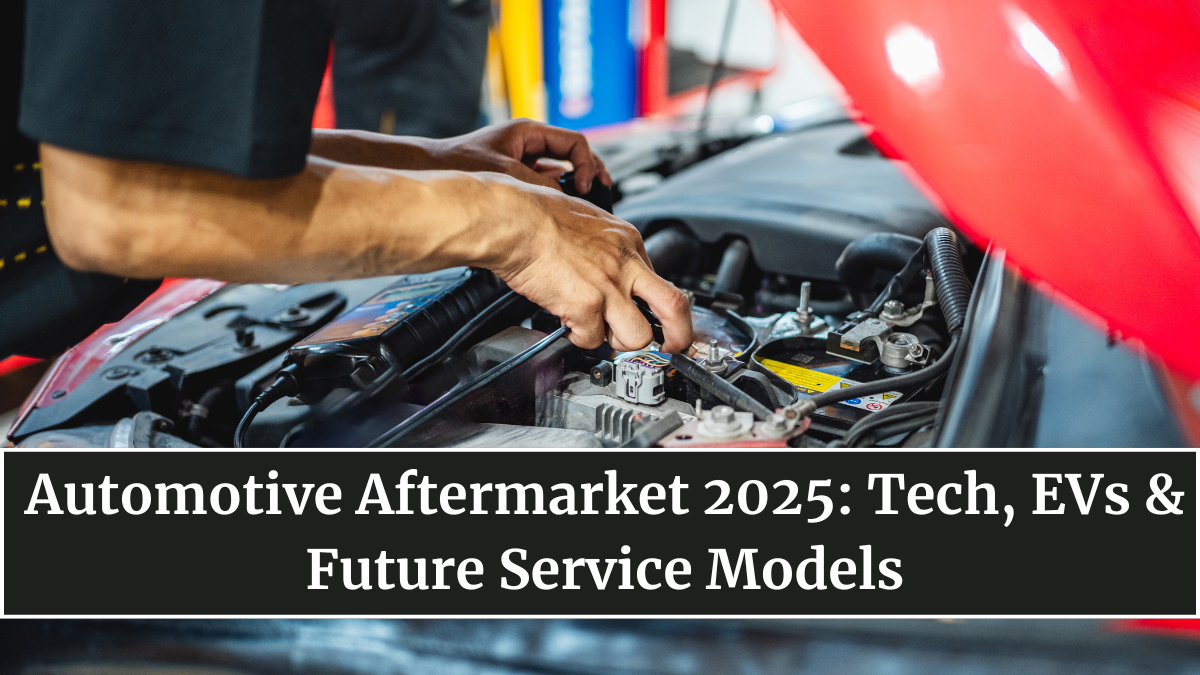The automotive aftermarket — once defined by oil changes, engine parts, and mechanical repairs — is now transforming into a tech-driven ecosystem. With the rise of electric vehicles, smart diagnostics, and AI-based servicing, the aftermarket auto industry in 2025 is being reimagined from the ground up.
As cars become computers on wheels, the industry’s focus is shifting from physical components to data, software, and predictive maintenance. The garages of tomorrow are turning into digital hubs — where vehicles talk, diagnose themselves, and even book their own service appointments.

How the EV Revolution Is Reshaping the Aftermarket
Electric vehicles are rewriting the rules of car maintenance. Unlike combustion engines, EVs have 90% fewer moving parts, eliminating many traditional services like oil changes, timing belts, and exhaust repairs.
However, new opportunities are emerging:
-
Battery servicing & recycling: As EV adoption rises, demand for battery health checks and recycling is booming.
-
Thermal management systems: Maintaining battery temperature is now a key aftermarket service.
-
Software diagnostics: Tech-driven updates, bug fixes, and feature upgrades have become standard maintenance practices.
-
EV tire wear: Instant torque increases tire degradation, creating new demand in tire aftermarket services.
This shift is steering mechanics, distributors, and garages toward electronics, software, and sustainability-focused operations.
Key Trends Defining the Aftermarket in 2025
Several groundbreaking trends are transforming how the aftermarket industry operates in 2025:
-
Digital Diagnostics and IoT Integration
Cars are now equipped with sensors and AI tools that detect issues before breakdowns occur. Mechanics access this data remotely for faster, more accurate repairs. -
Predictive Maintenance Using AI
Cloud-based AI predicts when components will fail, reducing downtime and increasing efficiency for both fleet and private owners. -
E-commerce Parts Distribution
Online sales of automotive parts have grown over 35% in the last year. Marketplaces are now using AI-driven logistics for faster, transparent delivery. -
Connected Vehicle Data Services
Data sharing between automakers and service providers allows customized maintenance plans and warranty tracking. -
Circular Economy Practices
Refurbishing, recycling, and reusing parts are becoming mainstream, cutting waste and costs for both manufacturers and consumers.
These developments are driving the aftermarket into a tech-first service era, where innovation replaces manual labor as the industry’s backbone.
The Role of Technology and Automation
Automation has become the foundation of the modern garage. Advanced technologies are replacing traditional workflows:
-
3D printing enables on-demand manufacturing of spare parts, reducing storage costs.
-
AR-assisted repairs guide technicians with step-by-step visual overlays.
-
Robotic diagnostics allow real-time scanning of electronic systems.
-
Cloud-based service software keeps track of maintenance histories and automatically schedules tune-ups.
Together, these tools enhance accuracy, reduce errors, and make vehicle servicing faster than ever before.
Opportunities for Startups and Entrepreneurs
2025 is proving to be a golden era for innovation in the automotive aftermarket. Startups are exploring niche opportunities such as:
-
Battery refurbishment and repurposing services
-
AI-based part recommendation engines
-
Mobile diagnostic vans for EVs
-
Smart supply chain management systems
-
Recycled material marketplaces for auto components
With India, the U.S., and Europe pushing for cleaner and more efficient transport systems, these startups are set to become key players in the next-gen vehicle service economy.
Challenges Ahead for the Industry
Despite its growth, the aftermarket faces challenges in adapting to a tech-dominated future:
-
Skill shortage: Traditional mechanics need retraining in electronics and diagnostics.
-
Data privacy issues: Connected vehicles raise concerns about ownership of vehicle data.
-
Standardization gaps: Lack of universal repair data access slows cross-brand servicing.
-
High equipment costs: Advanced diagnostic tools and EV-compatible infrastructure are expensive for small garages.
Solving these challenges will require stronger partnerships between automakers, software firms, and independent service providers.
The Future of the Automotive Aftermarket
By 2030, the global automotive aftermarket is projected to exceed $600 billion, with EV-related services accounting for nearly 40% of that value. The industry is steadily transitioning from reactive repairs to predictive, data-led maintenance, where every vehicle communicates its needs autonomously.
The workshop of tomorrow will look less like a mechanic’s garage and more like a tech laboratory, with software engineers, battery specialists, and AI analysts replacing traditional technicians.
In 2025 and beyond, success in the aftermarket won’t just depend on tools and wrenches — it will depend on code, data, and innovation.
FAQs
What is the automotive aftermarket?
It refers to the secondary market of vehicle maintenance, repairs, parts, and accessories after the original sale.
How is the EV shift impacting the aftermarket?
EVs require fewer mechanical repairs but increase demand for battery, software, and electronic servicing.
What technologies are transforming the aftermarket?
AI diagnostics, IoT sensors, predictive analytics, and cloud-based service management tools are leading the change.
Why is data important in the aftermarket industry?
Vehicle data enables predictive maintenance, personalized service plans, and improved customer transparency.
What’s the future outlook for the automotive aftermarket?
The aftermarket will become a tech-first sector dominated by software-driven services, sustainable operations, and digital commerce by 2030.
Click here to know more.
